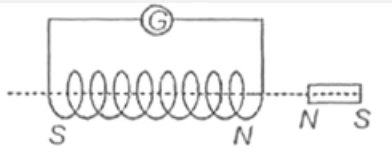The north pole of a long bar magnet was pushed slowly into a short solenoid connected to a galvanmeter. The magnet was held stationary for a few seconds with the north pole in the middle of the solenoid and then withdrawn repidly. The maximum deflection of the galvanometer was observed when the magnet was
moving toward the solenoid
moving into the solenoid
at rest inside the solenoid
moving out of the solenoid
The correct Answer is:D
To solve the problem, we need to analyze the behavior of the galvanometer when the north pole of a bar magnet is moved in relation to a solenoid. Here’s a step-by-step breakdown of the solution:
Step 1: Understanding the Setup
We have a long bar magnet and a short solenoid connected to a galvanometer. The north pole of the magnet is pushed into the solenoid, held stationary, and then withdrawn rapidly.
Step 2: Identifying the Conditions for Induced EMF
According to Faraday's law of electromagnetic induction, an electromotive force (EMF) is induced in the solenoid when there is a change in magnetic flux through it. The induced EMF is proportional to the rate of change of magnetic flux.
Step 3: Analyzing the Movement of the Magnet
1. Moving Towards the Solenoid: As the north pole of the magnet approaches the solenoid, the magnetic flux through the solenoid increases. This will induce a current in the solenoid and cause a deflection in the galvanometer.
2. At Rest Inside the Solenoid: When the magnet is held stationary inside the solenoid, there is no change in magnetic flux. Therefore, there is no induced EMF and no deflection in the galvanometer.
3. Moving Out of the Solenoid: When the magnet is withdrawn rapidly from the solenoid, the magnetic flux through the solenoid decreases rapidly. This rapid change in flux induces a current in the opposite direction, leading to a maximum deflection in the galvanometer.
Step 4: Conclusion
The maximum deflection of the galvanometer occurs when the magnet is withdrawn rapidly from the solenoid. Thus, the correct answer is that the maximum deflection is observed when the magnet is moving out of the solenoid.
Final Answer:
The maximum deflection of the galvanometer was observed when the magnet was moving out of the solenoid.
---
We have a long bar magnet and a short solenoid connected to a galvanometer. The north pole of the magnet is pushed into the solenoid, held stationary, and then withdrawn rapidly.
According to Faraday's law of electromagnetic induction, an electromotive force (EMF) is induced in the solenoid when there is a change in magnetic flux through it. The induced EMF is proportional to the rate of change of magnetic flux.
1. Moving Towards the Solenoid: As the north pole of the magnet approaches the solenoid, the magnetic flux through the solenoid increases. This will induce a current in the solenoid and cause a deflection in the galvanometer.
2. At Rest Inside the Solenoid: When the magnet is held stationary inside the solenoid, there is no change in magnetic flux. Therefore, there is no induced EMF and no deflection in the galvanometer.
The maximum deflection of the galvanometer occurs when the magnet is withdrawn rapidly from the solenoid. Thus, the correct answer is that the maximum deflection is observed when the magnet is moving out of the solenoid.
The maximum deflection of the galvanometer was observed when the magnet was moving out of the solenoid.
Topper's Solved these Questions
- ELECTROMAGNETIC INDUCTIONBook:NCERT FINGERTPS ENGLISHChapter:ELECTROMAGNETIC INDUCTIONExercise:EXEMPLAR PROBLEMS
Explore 3 Videos
- ELECTROMAGNETIC INDUCTIONBook:NCERT FINGERTPS ENGLISHChapter:ELECTROMAGNETIC INDUCTIONExercise:ASSERTION AND REASON
Explore 15 Videos
- ELECTRIC CHARGES AND FIELDSBook:NCERT FINGERTPS ENGLISHChapter:ELECTRIC CHARGES AND FIELDSExercise:Assertion And Reason
Explore 15 Videos
- ELECTROMAGNETIC WAVESBook:NCERT FINGERTPS ENGLISHChapter:ELECTROMAGNETIC WAVESExercise:Assertion And Reason
Explore 15 Videos
Similar Questions
A long bar magnet has a pole strength of 10Am. Find the magnetic field at a point on the axis of the magnet at a distance of 5cm from the north pole of the magnet.
View SolutionCompare the direction of the magnetic field inside a solenoid with that of the field there if the solenoid is replaced by its equivalent combination of north pole and south pole.
View Solution
Knowledge Check
The north pole of a bar magnet is rapidly introduced into a solenoid at one end (say A). Which of the following statements correctly depicts the phenomenon taking place?
ANo induced emf is developed.BThe end A of the solenoid behaves like a south pole.CThe end A of the solenoid behaves like north pole.DThe end A of the solenoid acquires positive potential.
When the N-pole of a bar magnet points towards the south and S-pole towards the north, the null points are at the
View SolutionA bar magnet is placed with its north pole towards geographic north. The neutral point
View SolutionA coil of insulate copper wire is connected to a galvanometer. What will happen if a bar magnet is (i) pushed into the coil, (ii) withdrawn from inside the coil, (iii) held stationary inside the coil ?
View SolutionThe north pole of a long horizontal bar magnet is being brought closer to a vertical conducting plane along the perpendicular direction. The direction of the induced current in the conducting plane will be
View SolutionA short bar magnet passes at a steady speed right through a'long solenoid. A galvanometer is connected across the solencid. Which graph best represents the variation of the galvanometer deflection with time t?

View SolutionTwo long bar magnets are placed with their axes coinciding in such a way that the north pole of the first magnet is 2.0cm from the south pole of the second. If both the magnets have a pole strength of 10Am, find the force exerted by one magnet on the other.
View SolutionA coil of insulated copper wire is connected to galvanometer. What would happen if a bar magnet is
(i) pushed into the coil?
(ii) withdrawn from inside the coil?
(iii) held stationary inside the coil?
View Solution